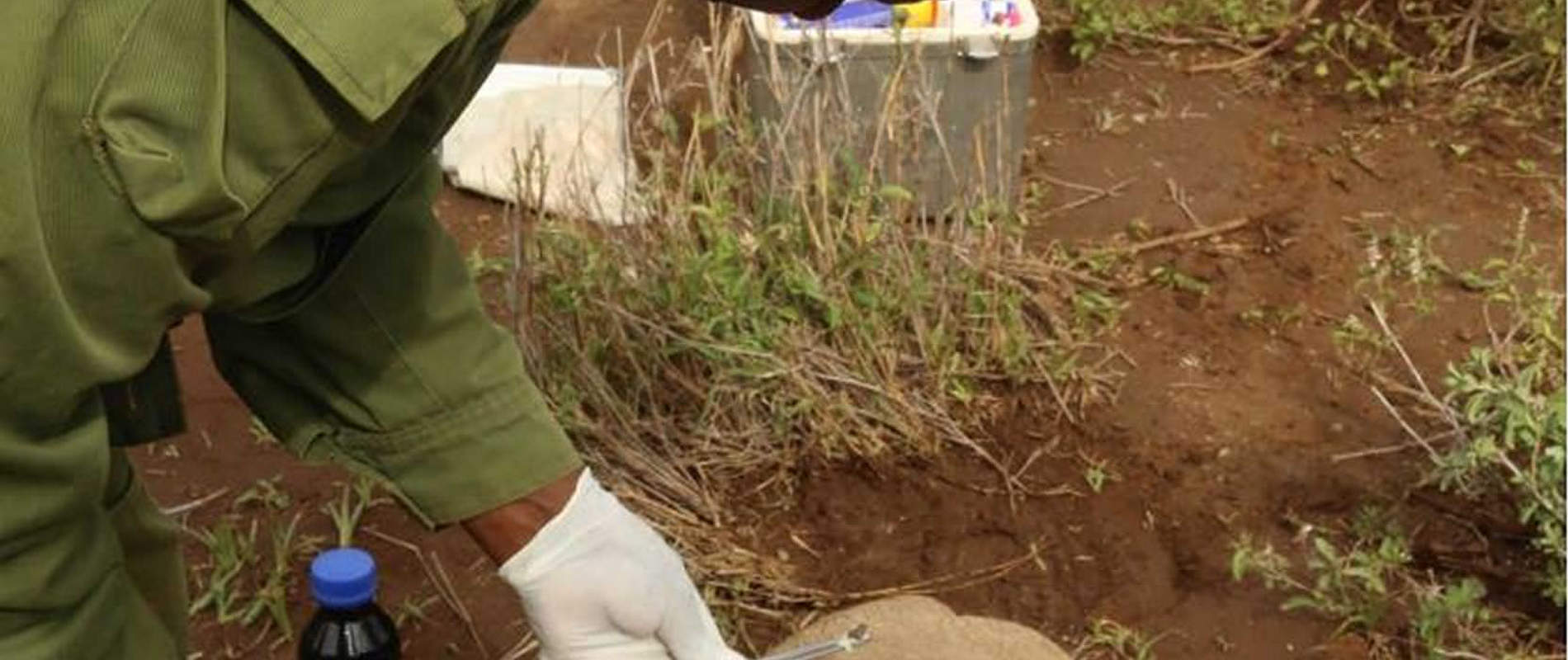The month of March witnessed heavy rainfall which has not been seen in the Tsavo ecosystem at this time of the year for the last 10 years
The month of March witnessed heavy rainfall which has not been seen in the Tsavo ecosystem at this time of the year for the last 10 years. The sudden rains flooded water pans across the park and turned the vegetation ravaged by last year’s drought lush and green. The cases handled dropped significantly due to wildlife dispersal across the ecosystem caused by abundant forage and water and consequently decrease in human-wildlife conflict. Cases handled include treatment of a huge Elephant bull with a leg injury near Amboseli National Park, immobilization and euthanasia of a snared Waterbuck in Taita Hills Sanctuary, treatment of a lame elephant cow near Bachuma, Tsavo East and examination of lionesses with facial growths in Taita Hills Wildlife Sanctuary.
CASE#1 TREATMENT OF AN ELEPHANT BULL
Date: 6th March 2018
Species: Loxodanta Africana (African Elephant)
Sex: Male
Age: Adult
Location: Amboseli National Park
GPS coordinates: 37M 0319192 UTM 9695091
History
A report of a lame huge elephant bull was received from the senior warden of Amboseli National Park. The well-known elephant bull with massive tusks had been seen days before with other bulls foraging and looking fine near the park, but today he was all alone near Kimana gate struggling to walk. As the Amboseli unit was away on off duty, the Tsavo vet was airlifted by DSWT aeroplane to Amboseli National Park. After landing they drove to the area to find the huge bull under a tree relaxing all alone with an obvious injury to one of his limbs. Darting equipments and immobilization drugs were prepared.
Immobilization, examination and treatment
The elephant was darted using 18 mgs of Etorphine from foot and went down on lateral recumbency.


The trunk and the ear were positioned correctly to aid in breathing and temperature control. There was a deep penetrating wound to the left hind leg just above the sole area with pus oozing out. Probing using clean tissue forceps indicated a deep penetrating wound that affected the joint. The wound was washed clean using water mixed with Hydrogen peroxide, necrotic tissues and pus were removed then the wound doused with tincture of iodine. Green clay was used to cover the wound. Long acting antibiotics were administered IM and dexamethasone Hcl given IV through the ear. Cause of injury is suspected to be a spear. After the treatment was done, the rest of the team were instructed to leave the area as the vet administered the reversal drug.
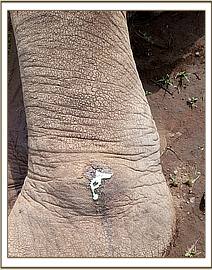


Reversal and Prognosis
The anaesthesia was reversed using Diprenorphine at 3 times the Etorphine dose and the elephant stood up, though with difficulty, and walked away slowly. Prognosis is guarded due to joint infection and will require a repeat treatment for better chances of healing.
CASE#2 TREATMENT OF A SNARED WATERBUCK
Date: 10th March 2018
Species: Water buck
Sex: Male
Age: Adult
Location: Taita Wildlife Sanctuary
GPS coordinates: 37M 0417898 UTM 9611104
A report was received from the honorary warden around Taita Hills regarding a snared waterbuck near Sarova Taita Lodge dam that was barely able to walk. The Tsavo Vet Unit got ready and rushed to the Wildlife Sanctuary to find the snared waterbuck lying down near the dam with a visible wire snare.
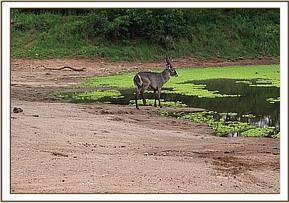

Immobilization and Management
The waterbuck was immobilised with 6 mgs of Etorphine Hcl mixed with 40 mgs of Xylazine and went down in 4 minutes. Examination revealed an extensive deep cut on the fetlock joint by the tough wire snare that nearly severed the hoof. The joint was completely damaged with skin, ligaments and synovial cavity all damaged exposing the distal condyle of tibia. The injury was given poor prognosis hence the waterbuck was euthanized by administration of 20 CC of euthanaze (20% Pentobarbitone Sodium) by rapid IV injection through the jugular vein.
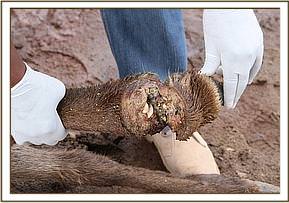

CASE#3 TREATMENT OF AN INJURED ELEPHANT COW
Date: 21st March 2018
Species: Loxodanta Africana (African Elephant)
Sex: Female
Age: Adult
Location: Bachuma, Tsavo East
GPS coordinates: 37M 0489299 UTM 9620714
A report was made by tour drivers regarding a lone elephant cow in Bachuma area of Tsavo East National Park foraging alone with no other herd nearby and showing signs of lameness while walking. The unit drove to the area from their base at park headquarters near Voi to find the lone cow busy feeding.
Immobilization, examination and treatment
A dart was prepared with 16mgs of Etorphine and then darted from a vehicle. She was immobilized in 5 minutes but unluckily fell on the injured limb. A rope tied to the unit vehicle and fastened on all four limbs was used to flip the elephant over. A section of the right front foots sole had peeled off leaving a raw and sensitive cushion innervated by meissners and pacinian corpuscles that made walking painful.
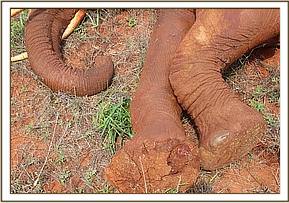

Dirt debris and necrotic tissues were scrubbed off, then the wound was cleaned using hydrogen peroxide mixed with water, doused with tincture of iodine and sprayed with Oxytetracycline spray. Wetted green clay was applied to aid in wound healing and keep off dirt and flies. Long acting antibiotics and Dexamethasone Hcl were administered parenterally.
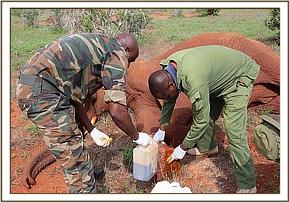

Reversal and Prognosis
Thee anaesthesia was reversed using Diprenorphine at 3 times the Etorphine dose. Other graze wounds from falling were also treated. The body condition of the elephant was not very good hence she was assisted onto her feet.
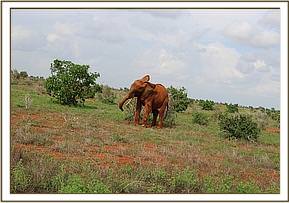
Prognosis given is good.
CASE#4 EXAMINATION OF LIONS WITH GROWTHS
Date: 25th March 2018
Species: Panthera leo(African Lion)
Sex: Female
Age: Adult
Location: Taita Salt Lick Sanctuary
GPS coordinates: 37M 0410788 UTM 9609807
History
The resident lions at Taita Sarova Sanctuary have been spotted several times by both tourists and local rangers with growths around the face that appear abnormal. The Vet was called in to examine the growths and to see whether they are transmissible. The team visited the Conservancy and after a thorough search the lions were found near Riverine vegetation. Visual examination by use of binoculars revealed abnormal growths around the whiskers.
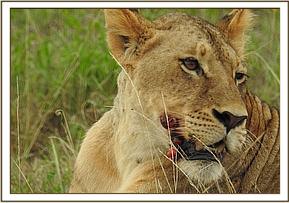
Immobilisation, examination and treatment
Immobilization was achieved with 300 mgs of Ketamine and 4 mgs of meditomidine Hcl. Tissue samples of the growths were taken and preserved in formalin, 70% ethanol and another frozen to be submitted to the laboratory for diagnosis.

Reversal
The lioness was revived using Yohimbine Hcl after 1 hour.
Other Activities
- The unit examined several wildlife trophies/parts and produced expert reports to aid in prosecution of the offenders in court and testified in Hola court in Tana River County and Voi court on the same.
Acknowledgement
The unit acknowledges the support of its sponsors ViER PFOTEN through the David Sheldrick Wildlife Trust (DSWT) for their immense financial contribution to the unit. We also thank Kenya Wildlife Service through the Assistant director Tsavo conservation area and the head, veterinary and capture services department for their support.
